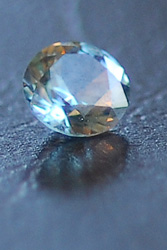State Gemstones Sapphire and Agate
Updated: August 10, 2020

Montana sapphires and Montana agates have shared honors as the state's gemstones since 1969. Recognition was a long time in coming. A century earlier the small multi-colored sapphires angered early placer miners by clogging gold sluices in such places as El Dorado Bar east of Helena. "Sapphire Collins" frequented the streets of Helena in the 1860s with a pocket full of pretty stones. Try as he might to convince local merchants and bankers of the stones' value, he was told bluntly that gold was of prime importance and that anything else was of little worth.

Eastern and European financiers weren't as shortsighted when they learned of Montana's sapphires in the early 1890s. Before long, substantial companies from as far away as London invested in sapphire mines throughout the state. On Quartz and Rock Creeks west of Philipsburg, or Brown's Gulch and Dry Cottonwood Creek east of Anaconda, or along the Missouri River at El Dorado Bar, French Bar, Magpie Gulch, Metropolitan Bar, and elsewhere, the rush was on. But the sapphire bonanza came in at Yogo Gulch in central Montana's Judith Basin Gulch.

Jake Hoover, friend of cowboy artist Charles Russell, made one of the earliest discoveries of Yogo sapphires. Looking for gold, he found the blue pebbles in the gravels of Yogo Creek in 1896. The Yogo mines attracted wide attention and capital. The U.S. Geological Survey termed the location "America's most important gem location." The British controlled the mines for nearly thirty years, explaining why the beautiful "Cornflower Blue" Yogos are found in the Royal Crown Jewel Collection in London. A unique quality of Yogo sapphires is that they retain their brilliance under artificial light. Sapphires from other parts of the world generally absorb artificial light, making them appear black and lusterless.
Over the years the Yogo mines have produced an estimated forty million dollars in the precious blue gems. The original Yogo mines are currently being worked by commercial companies. The largest cut Yogo is 10.2 carats and is in the Smithsonian Institution in Washington, D.C.

Montana's Council of Rock and Mineral Clubs supported not only the sapphire for gemstone honors, but advocated equal recognition for the exquisite and ever-varying Montana agate, found in abundance along the Yellowstone River to the east. Cut and polished, the agate is a beautiful addition to jewelry and a much-sought-after gem.
Between the sapphire and the agate, Montana's east and west, heritage and hobbies, are represented.
Special Acknowledgements to: Montana Historical Society, Rex C. Meyers and Norma B. Ashby
Updated: August 10, 2020

